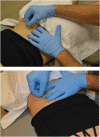Effect of dry needling on lumbar muscle stiffness in patients with low back pain: A double blind, randomized controlled trial using shear wave elastography
- PMID: 34525901
- PMCID: PMC9255226
- DOI: 10.1080/10669817.2021.1977069
Effect of dry needling on lumbar muscle stiffness in patients with low back pain: A double blind, randomized controlled trial using shear wave elastography
Abstract
Background: Dry needling treatment focuses on restoring normal muscle function in patients with musculoskeletal pain; however, little research has investigated this assertion. Shear wave elastography (SWE) allows quantification of individual muscle function by estimating both resting and contracted muscle stiffness.
Objective: To compare the effects of dry needling to sham dry needling on lumbar muscle stiffness in individuals with low back pain (LBP) using SWE.
Methods: Sixty participants with LBP were randomly allocated to receive one session of dry needling or sham dry needling treatment to the lumbar multifidus and erector spinae muscles on the most painful side and spinal level. Stiffness (shear modulus) of the lumbar multifidus and erector spinae muscles was assessed using SWE at rest and during submaximal contraction before treatment, immediately after treatment, and 1 week later. Treatment effects were estimated using linear mixed models.
Results: After 1 week, resting erector spinae muscle stiffness was lower in individuals who received dry needling than those that received sham dry needling. All other between-groups differences in muscle stiffness were similar, but non-significant.
Conclusion: Dry needling appears to reduce resting erector spinae muscle following treatment of patients with LBP. Therefore, providers should consider the use of dry needling when patients exhibit aberrant stiffness of the lumbar muscles.
Keywords: Dry needling; elastography; low back pain; muscle; ultrasound.
Conflict of interest statement
No potential conflict of interest was reported by the author(s).
Figures





References
-
- Vulfsons S, Ratmansky M, Kalichman L. Trigger Point Needling: techniques and Outcome. Curr Pain Headache Rep. 2012. May;16(5):407–412. - PubMed
-
- France S, Bown J, Nowosilskyj M, et al. Evidence for the use of dry needling and physiotherapy in the management of cervicogenic or tension-type headache: a systematic review. Cephalalgia. 2014. October;34(12):994–1003. - PubMed
-
- Gattie E, Cleland JA, Snodgrass S. The Effectiveness of Trigger Point Dry Needling for Musculoskeletal Conditions by Physical Therapists: a Systematic Review and Meta-analysis. J Orthop Sports Phys Ther. 2017. Mar;47(3):133–149. - PubMed
Publication types
MeSH terms
LinkOut - more resources
Full Text Sources
Medical
Miscellaneous
